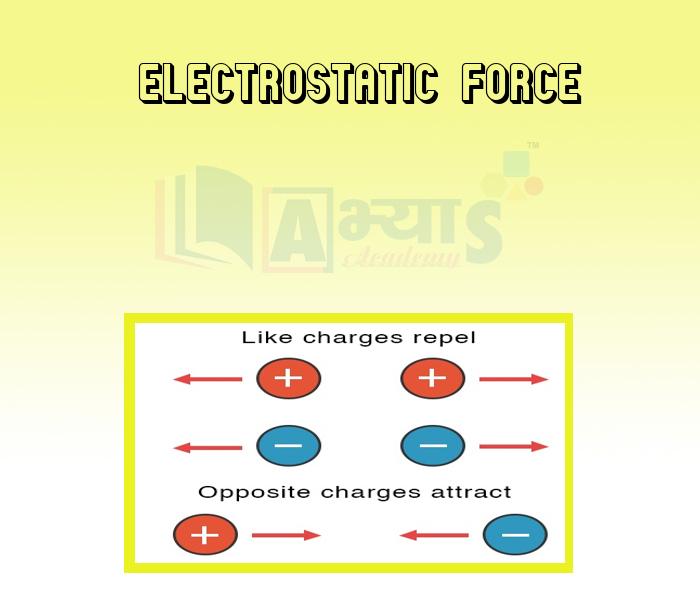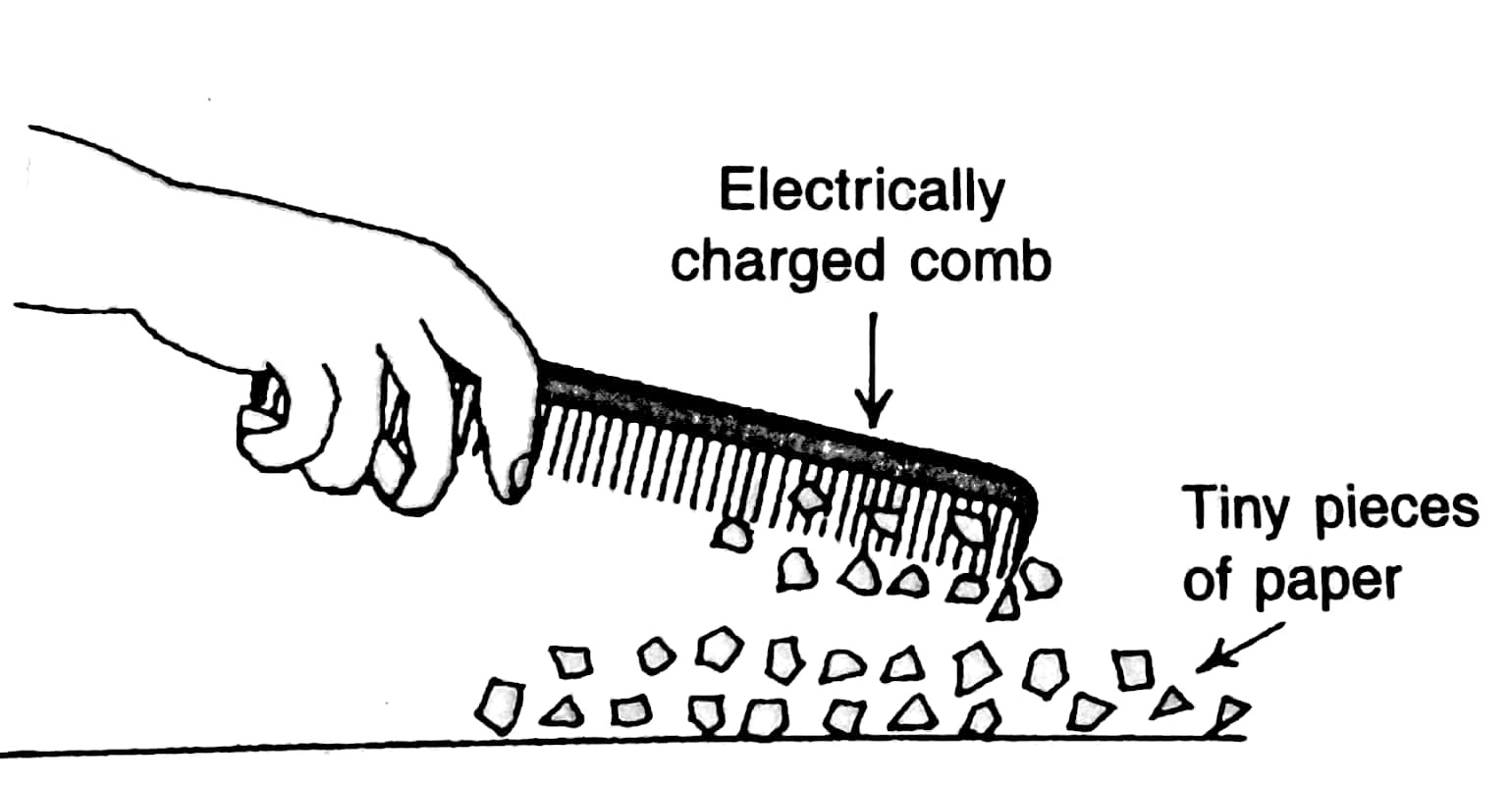Electrostatic Force





Electrostatic Force
Electrically charged objects exert force on an uncharged object or a charged object is called electrostatic force. For example, a plastic comb or plastic pen which is electrically charged by rubbing in dry hair, exerts an electrostatic force on uncharged tiny pieces of paper and attracts them.
The electric charges are of two types: positive electric charges and negative electric charges. Electric charges can be produced by friction when one object is rubbed over another object. The term 'electrostatic' refers to 'stationary electric charges'. An object having stationary electric charges (or static electric charges) on it is called electrically charged object. A comb acquires electrostatic charge after it has been rubbed with dry hair. An electrically charged object exerts an electrostatic force. It is called electrostatic force because the electric charges involved in it remain static (or stationary). The electric charges remain confined to the charged object and do not move.
Activity: To show that electrically charged by rubbing in dry hair, exerts an electrostatic force on uncharged tiny pieces of paper
1. Take a plastic comb (or plastic pen) and rub it in dry hair for about one minute.

2. Bring this comb near the tiny pieces of paper.

Observation: The comb attracts the tiny pieces of paper. The tiny pieces of paper move towards the comb and stick to it.
Explanation: When the plastic comb is rubbed in dry hair, the comb gets electric charges by friction. And when this electrically charged comb is brought near the tiny pieces of paper, it exerts an electrostatic force of attraction on them. Due to this electrostatic force, the tiny pieces of paper move towards the comb and stick to it.
Some more example of electrostatic force are
1 The electrostatic force is responsible for raising our body hair when we try to take off a terylene or polyester shirt in dry weather.

2. An inflated balloon when rubbed with a piece of synthetic cloth and then pressed against a wall, the balloon sticks to the wall. It is the electrostatic force which is responsible for the attraction between the balloon and the wall.

As the electrostatic force can be exerted by a charged object on another object from a distance, so it is an example of a non-contact force. Just like magnetic force, an electrostatic force can be of attraction or repulsion depending on the situation. The electrostatic force between any charged object (positively charged object or negatively charged object) and an uncharged object is always of attraction. The electrostatic force between two charged objects having like charges is that of repulsion. On the other hand, the electrostatic force between two charged objects having unlike charges is of attraction.
The force an electrically charged objects exert on an uncharged object or a charged object is called _____________ . | |||
| Right Option : A | |||
| View Explanation | |||
Photocopy works on the principle of __________ | |||
| Right Option : B | |||
| View Explanation | |||
Electric charges can be produced by ___________________ when one object is rubbed over another object. | |||
| Right Option : A | |||
| View Explanation | |||
Students / Parents Reviews [20]
Abhyas is an institute of high repute. Yogansh has taken admission last year. It creates abilities in child to prepare for competitive exams. Students are motivated by living prizes on basis of performance in Abhyas exams. He is satisfied with institute.

Yogansh Nyasi
7thIt has a great methodology. Students here can get analysis to their test quickly.We can learn easily through PPTs and the testing methods are good. We know that where we have to practice

Barkha Arora
10thAbhyas academy is great place to learn. I have learnt a lot here they have finished my fear of not answering.It has created a habit of self studying in me.The teachers here are very supportive and helpful. Earlier my maths and science was good but now it has been much better than before.

Barkha Arora
10thMy experience with Abhyas Academy has been very good. When I was not in Abhyas whenever teacher ask questions I could not speak it confidently but when I came in Abhyas, my speaking skills developed and now I am the first one to give the answer of teachers question.

Upmanyu Sharma
7thThe experience was nice. I studied here for three years and saw a tremendous change in myself. I started liking subjects like English and SST which earlier I ran from. Extra knowledge gave me confidence to overcome competitive exams. One of the best institutes for secondary education.

Aman Kumar Shrivastava
10thAbhyas is good institution and a innovative institute also. It is a good platform of beginners.Due to Abhyas,he has got knoweledge about reasoning and confidence.My son has improved his vocabulary because of Abhyas.Teacher have very friendly atmosphere also.

Manish Kumar
10thAbhyas institute is one of the best coaching institute in the vicinity of Ambala Cantt area. The teachers of the institute are well experienced and very helpful in solving the problems of the students.The good thing of the institute is that it is providing extra classes for the students who are w...

Aman Kumar Shrivastava
10thAbhyas is a complete education Institute. Here extreme care is taken by teacher with the help of regular exam. Extra classes also conducted by the institute, if the student is weak.

Om Umang
10thWe started with lot of hope that Abhyas will help in better understnding of complex topics of highers classes. we are not disappointed with the progress our child has made after attending Abhyas. Though need to mention that we expected a lot more. On a scale of 1-10, we would give may be 7.

Manya
8thUsually we see institutes offering objective based learning which usually causes a lag behind in subjective examinations which is the pattern followed by schools. I think it is really a work of planning to make us students grab the advantages of modes of examination, Objective Subjective and Onli...

Anika Saxena
8thIt was good as the experience because as we had come here we had been improved in a such envirnment created here.Extra is taught which is beneficial for future.

Eshan Arora
8thMy experience was very good with Abhyas academy. I am studying here from 6th class and I am satisfied by its results in my life. I improved a lot here ahead of school syllabus.

Ayan Ghosh
8thA marvelous experience with Abhyas. I am glad to share that my ward has achieved more than enough at the Ambala ABHYAS centre. Years have passed on and more and more he has gained. May the centre flourish and develop day by day by the grace of God.

Archit Segal
7thAbhyas institute is one of the best coaching institute in the vicinity of Ambala cantt.The institute provides good and quality education to the students.The teachers are well experienced and are very helpful in solving the problems. The major advantages of the institute is extra classes for weak...

Shreya Shrivastava
8thIt was a good experience with Abhyas Academy. I even faced problems in starting but slowly and steadily overcomed. Especially reasoning classes helped me a lot.

Cheshta
10thBeing a parent, I saw my daughter improvement in her studies by seeing a good result in all day to day compititive exam TMO, NSO, IEO etc and as well as studies. I have got a fruitful result from my daughter.

Prisha Gupta
8thOne of the best institutes to develope a child interest in studies.Provides SST and English knowledge also unlike other institutes. Teachers are co operative and friendly online tests andPPT develope practical knowledge also.

Aman Kumar Shrivastava
10thIn terms of methodology I want to say that institute provides expert guidence and results oriented monitering supplements by requsite study material along with regular tests which help the students to improve their education skills.The techniques of providing education helps the students to asses...

Aman Kumar Shrivastava
10thMy experience with Abhyas is very good. I have learnt many things here like vedic maths and reasoning also. Teachers here first take our doubts and then there are assignments to verify our weak points.

Shivam Rana
7thAbhyas Methodology is very good. It is based on according to student and each child manages accordingly to its properly. Methodology has improved the abilities of students to shine them in future.
